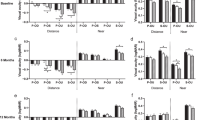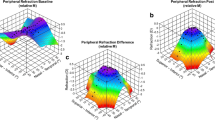Abstract
Purpose
To evaluate differences in the subjective aniseikonia and stereoacuity in patients with axial anisometropia after full correction of the refractive error with spectacles, contact lenses, and refractive surgery.
Methods
A prospective study was performed in Cairo University Hospitals on 20 patients with axial anisometropia caused by unilateral myopia > 5 D with > 4 D inter-ocular difference in spherical equivalent who were suitable candidates for excimer laser ablation (LASIK) or implantable collamer lens implantation (ICL). All patients had measurement of best-corrected visual acuity (BCVA), fusion, stereoacuity, and magnitude of aniseikonia with spectacles, contact lenses, and after surgery.
Results
The mean age at time of surgery was 25.7 ± 3.1 years. There were no statistically significant differences in the BCVA or stereoacuity with spectacles, contact lenses, or after refractive surgery. Microkonia < 5%) was perceived with spectacles in 8 patients (40%) and remained unchanged in 7 of these 8 patients with contact lenses. Following LASIK (n = 11), there was an induced macrokonia < 2% in 4 patients (36%), persistent microkonia of 3% in 1 patient (9%), and no change in image size in 6 (55%) patients. Following ICL implantation (n = 9), there was a perceived macrokonia of 2% in 4 patients (44%), disappearance of microkonia in 1 patient (11%) and no change in 4 patients (44%).
Conclusions
Differences in BCVA, stereoacuity, and aniseikonia after correction of anisometropia by glasses, contact lens and surgery are both clinically and statistically insignificant. Retinal or neural adaptation might have a role in correction for differences in image size.




Similar content being viewed by others
Data availability
Data are available from the corresponding author upon request.
References
Benjamin WT (2006) Borish’s clinical refraction. Butterworth-Heinemann, Oxford
Sorsby A, Leary GA, Richards MJ (1962) The optical components in anisometropia. Vision Res 2:43–51. https://doi.org/10.1016/0042-6989(62)90062-7
Achiron LR, Witkin N, Primo S, Broocker G (1997) Contemporary management of aniseikonia. Surv Ophthalmol 41:321–330. https://doi.org/10.1016/S0039-6257(96)00005-7
Pascal JI (1955) Retinal image in axial and refractive ametropia. Br J Ophthalmol 39:380–381. https://doi.org/10.1136/bjo.39.6.380
Knapp H (1869) The influence of spectacles on the optical constants and visual acuteness of the eye. Arch Ophthalmol Otolaryngol 1:377–410
Winn B, Ackerley RG, Brown CA, Murray FK, Prais J, St John MF (1988) Reduced aniseikonia in axial anisometropia with contact lens correction. Ophthalmic Physiol Opt 8:341–344. https://doi.org/10.1111/j.1475-1313.1988.tb01064.x
Finlay AL (2007) Binocular vision and refractive surgery. Contact Lens Anterior Eye 30:76–83. https://doi.org/10.1016/j.clae.2007.02.009
Autrata R, Rehurek J (2004) Laser-assisted subepithelial keratectomy and photorefractive keratectomy versus conventional treatment of myopic anisometropic amblyopia in children. J Cataract Refract Surg 30:74–84. https://doi.org/10.1016/S0886-3350(03)00417-6
Astle WF, Fawcett SL, Huang PT, Alewenah O, Ingram A (2008) Long-term outcomes of photorefractive keratectomy and laser-assisted subepithelial keratectomy in children. J Cataract Refract Surg 34:411–416. https://doi.org/10.1016/j.jcrs.2007.10.027
Althomali TA (2013) Posterior chamber toric phakic IOL implantation for the management of pediatric anisometropic amblyopia. J Refract Surg 29:396–400. https://doi.org/10.3928/1081597X-20130410-01
Rutstein RP, Daum KM (1998) Anomalies of binocular vision: diagnosis and management. Mosby, St. Louis
Dabir S, Mangalesh S, Schouten JS, Berendschot TT, Kurian MK, Kumar AK, Yadav NK, Shetty R (2015) Axial length and cone density as assessed with adaptive optics in myopia. Indian J Ophthalmol 63:423–426. https://doi.org/10.4103/0301-4738.159876
Bradley A, Rabin J, Freeman RD (1983) Nonoptical determinants of aniseikonia. Invest Ophthalmol Vis Sci 24:507–512
Romano PE, von Noorden GK (1999) Knapp’s law and unilateral axial high myopia. 1970. Binocul Vis Strabismus Q 14:215–222
Randleman JB, Russell B, Ward MA, Thompson KP, Stulting RD (2003) Risk factors and prognosis for corneal ectasia after LASIK. Ophthalmology 110:267–275. https://doi.org/10.1016/S0161-6420(02)01727-X
García-Pérez MA, Peli E (2015) Aniseikonia tests: the role of viewing mode, response bias, and size-color illusions. Transl Vis Sci Technol 4(3):9. https://doi.org/10.1167/tvst.4.3.9
Lebensohn JE (1957) The management of anisometropia. Am Orthopt J 7:121–128. https://doi.org/10.1080/0065955x.1957.11981213
Rose L, Levinson A (1972) Anisometropia and aniseikonia. Am J Optom Arch Am Acad Optom 49:480–484. https://doi.org/10.1097/00006324-197206000-00003
Winn B, Ackerley RG, Brown CA, Murray FK, Prais J, St. John MF (1986) The superiority of contact lenses in the correction of all anisometropia. J Br Contact Lens Ass 9:95–100. https://doi.org/10.1016/S0141-7037(86)80034-9
Cotter SA, Pediatric Eye Disease Investigator Group, Edwards AR, Wallace DK, Beck RW, Arnold RW, Astle WF, Barnhardt CN, Birch EE, Donahue SP, Everett DF, Felius J, Holmes JM, Kraker RT, Melia M, Repka MX, Sala NA, Silbert DI, Weise KK (2006) Treatment of anisometropic amblyopia in children with refractive correction. Ophthalmology 113:895–903. https://doi.org/10.1016/j.ophtha.2006.01.068
Chen PL, Chen JT, Tai MC, Fu JJ, Chang CC, Lu DW (2007) Anisometropic amblyopia treated with spectacle correction alone: possible factors predicting success and time to start patching. Am J Ophthalmol 143:54–60. https://doi.org/10.1016/j.ajo.2006.09.027
Moseley MJ, Fielder AR, Stewart CE (2009) The optical treatment of amblyopia. Optom Vis Sci 86:629–633. https://doi.org/10.1097/OPX.0b013e3181a7b3e5
Awadein A, Fakhry MA (2011) Changes in binocular function in anisometropic nonstrabismic children with optical correction and occlusion therapy. J AAPOS 15:545–550. https://doi.org/10.1016/j.jaapos.2011.07.008
Rutstein RP, Corliss DA, Fullard RJ (2006) Comparison of aniseikonia as measured by the aniseikonia inspector and the space eikonometer. Optom Vis Sci 83:836–842. https://doi.org/10.1097/01.opx.0000238722.34167.cc
Bannon RE (1953) Space eikonometry in aniseikonia. Am J Optom Arch Am Acad Optom 30:86–98. https://doi.org/10.1097/00006324-195302000-00009
Awaya S, Sugawara M, Horibe F, Torii F (1982) The, “New Aniseikonia Tests” and its clinical application. Acta Soc Ophthalmol Jpn 86:217–222
Ogle KN (1964) Researches in binocular vision. Hafner Publishing Co, New York
McCormack G, Peli E, Stone P (1992) Differences in tests of aniseikonia. Invest Ophthalmol Vis Sci 33:2063–2067
Kehler LA, Fraine L, Lu P (2014) Evaluation of the aniseikonia inspector version 3 in school-aged children. Optom Vis Sci 91:528–532. https://doi.org/10.1097/OPX.0000000000000245
Acknowledgements
None.
Funding
None.
Author information
Authors and Affiliations
Corresponding author
Ethics declarations
Conflict of interest
The authors declare that they have no conflict of interest.
Ethics approval
The study protocol was approved by Cairo University Research Ethics Committee. The study and data collection conformed to all local laws and were compliant with the principles of the Declaration of Helsinki.
Consent to participate
Written informed consent was obtained from the patients included in the study.
Consent for publication
All authors approved the final version of the manuscript.
Additional information
Publisher's Note
Springer Nature remains neutral with regard to jurisdictional claims in published maps and institutional affiliations.
Supplementary Information
Below is the link to the electronic supplementary material.
10792_2021_2161_MOESM1_ESM.tif
Scatter plot showing attempted spherical equivalent correction vs. the achieved equivalent correction in the LASIK (left panel) and the ICL (right panel) groups. (TIF 731 kb)
10792_2021_2161_MOESM2_ESM.tif
Histogram showing the frequency distribution of the postoperative spherical equivalent refraction in the LASIK (left panel) and the ICL (right panel) groups. (TIF 518 kb)
10792_2021_2161_MOESM3_ESM.tif
Histogram showing the frequency distribution of the pre- and post-operative astigmatic error in the LASIK (left panel) and the ICL (right panel) groups. (TIF 581 kb)
10792_2021_2161_MOESM4_ESM.tif
Line graph showing the changes in the refraction in the first 3 months in the LASIK (left panel) and the ICL (right panel) groups. (TIF 485 kb)
10792_2021_2161_MOESM5_ESM.tif
Histogram showing the cumulative frequency distribution of the Snellen’s visual acuity in the LASIK (left panel) and the ICL (right panel) groups. (TIF 507 kb)
10792_2021_2161_MOESM6_ESM.tif
Histogram showing the frequency distribution of the corrected-distance visual acuity in the LASIK (left panel) and the ICL (right panel) groups. (TIF 436 kb)
Rights and permissions
About this article
Cite this article
Abdelzaher, H.A., Sidky, M.K., Awadein, A. et al. Aniseikonia and visual functions with optical correction and after refractive surgery in axial anisometropia. Int Ophthalmol 42, 1669–1677 (2022). https://doi.org/10.1007/s10792-021-02161-w
Received:
Accepted:
Published:
Issue Date:
DOI: https://doi.org/10.1007/s10792-021-02161-w




